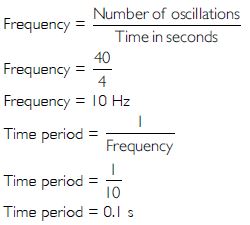Question 1:
Sound can travel through
- gases only
- solids only
- liquids only
- solids, liquids and gases
Answer:
solids, liquids and gases
Question 2:
Voice of which of the following is likely to have minimum frequency?
- Baby girl
- Baby boy
- A man
- A woman
Answer:
A man
Question 3:
Sound cannot travel in vacuum.
- TRUE
- FALSE
Answer:
TRUE
Question 4:
The number of oscillations per second of a vibrating object is called its time period.
- TRUE
- FALSE
Answer:
FALSE
Question 5:
If the amplitude of vibration is large, sound is feeble.
- TRUE
- FALSE
Answer:
FALSE
Question 6:
For human ears, the audible range is 20 Hz to 20,000 Hz.
- TRUE
- FALSE
Answer:
TRUE
Question 7:
The lower the frequency of vibration, the higher is the pitch.
- TRUE
- FALSE
Answer:
FALSE
Question 8:
Unwanted or unpleasant sound is termed as music.
- TRUE
- FALSE
Answer:
FALSE
Question 9:
Noise pollution may cause partial hearing impairment.
- TRUE
- FALSE
Answer:
TRUE
Question 10:
Time taken by an object to complete one oscillation is called _________.
Answer:
time period
Question 11:
Loudness is determined by the _________ of vibration.
Answer:
amplitude
Question 12:
The unit of frequency is _________.
Answer:
Hertz
Question 13:
Unwanted sound is called _________
Answer:
noise
Question 14:
Shrillness of a sound is determined by the _________ of the vibration.
Answer:
frequency
Question 15:
A pendulum oscillates 40 times in 4 seconds. Find its time period and frequency.
Answer:
Question 16:
The sound from a mosquito is produced when it vibrate its wings at an average rate of 500 vibrations per second. What is the time period of the vibration?
Answer:
Question 17:
Identify the part which vibrates to produce sound in the following instruments:
(a) Dholak (b) Sitar (c) Flute
Answer:
(a) Stretched membrane
(b) String
(c) Air column
Question 18:
What is the difference between noise and music? Can music become noise sometimes?
Answer:
Differences between noise and music are:
Yes, music can become noise. When music is too loud or the sounds produced by the instruments are not in sync with each other, then music becomes noise.
Question 19:
List sources of noise pollution in your surroundings.
Answer:
Sources of noise pollution are:
(i) Noise of vehicles
(ii) Loudspeakers
(iii) Working machines
(iv) Bursting of crackers
(v) Air coolers
(vi) Radios and televisions at high volumes
(vii) Kitchen appliances
(viii) Hawkers etc.
Question 20:
Explain in what ways noise pollution is harmful to human.
Answer:
Too much noise in our surroundings is known as noise pollution. It is very harmful to us and can cause irritability, loss of concentration, high blood pressure, headache, stress, sleep disturbances, etc. It can even damage hearing permanently.
Question 21:
Your parents are going to buy a house. They have been offered one on the roadside and another three lanes away from the roadside. Which house would you suggest your parents should buy?Explain your answer.
Answer:
My parents should buy the house, which is located three lanes away from the roadside because a roadside house has many disadvantages such as:
(i) Lot of noise due to passing vehicles.
(ii) Smoke and dust produced by running vehicles.
(iii) Sound of loud horns of vehicles at the time of traffic jams.
Question 22:
Sketch larynx and explain its function in your own words.
Answer:
Functions of larynx: When air passes through the vocal cords, they vibrate to produce sound. Vocal cords may become loose/thick or tight/thin due to vibrations, thus producing different types of sounds.
Question 23:
Lightning and thunder take place in the sky at the same time and at the same distance from us. Lightning is seen earlier and thunder is heard later. Can you explain why?
Answer:
The speed of light is 3 × 108 m/s, while that of sound is only 330 m/s. So, although lightning and thunder take place simultaneously in the sky and at the same distance from the Earth, lightening is seen first.




